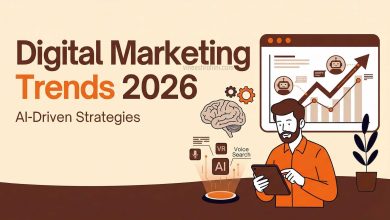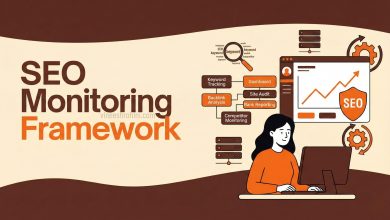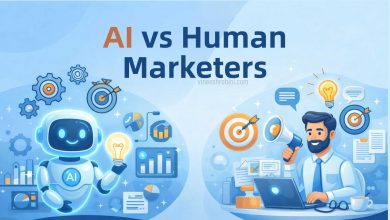Using AI for Market Research in 2025 : Comprehensive Guide
AI for Market Research : In the fast-evolving landscape of digital business and data-driven decision-making, the role of artificial intelligence (AI) in market research has transformed from a novelty to a necessity. As we step into 2025, the use of AI for market research is no longer confined to tech giants or data scientists. It has become an accessible and essential tool for startups, SMEs, global corporations, and even solopreneurs.
Table of Contents
From gathering real-time consumer insights to predicting future trends and optimizing product strategies, AI technologies are redefining how market research is conducted, analyzed, and applied. This comprehensive guide explores how AI is revolutionizing market research in 2025, the tools available, benefits, limitations, and how businesses can fully leverage this technology to gain a competitive edge.
The Evolution of Market Research with AI

Traditional market research methods—such as focus groups, surveys, and manual data analysis—are labor-intensive, time-consuming, and often suffer from human biases and limited data pools. AI-powered market research, on the other hand, utilizes machine learning algorithms, natural language processing (NLP), data mining, and predictive analytics to gather, process, and interpret vast amounts of data at lightning speed. This allows businesses to access real-time insights, detect trends earlier, and understand consumer behavior with a level of accuracy and depth that was previously unimaginable.
Also Read : Best 5 AI Tools for Digital Marketing
By 2025, AI has matured significantly in both capability and affordability. Tools once exclusive to enterprise-level businesses are now being widely adopted by small to medium-sized enterprises. Platforms that integrate AI with market research processes offer features like automated sentiment analysis, voice-of-customer (VoC) tracking, competitor benchmarking, and customer journey mapping—without the need for a full-time research team.
Why AI-Driven Market Research is Critical in 2025
In an age where consumer preferences evolve rapidly and competitors can appear overnight, businesses must make faster, smarter decisions. AI-driven market research meets this demand by providing:
- Real-time data collection and analysis
- Hyper-personalized customer insights
- Automated trend forecasting
- Deep sentiment and emotion analysis
- Scalable research capabilities across regions and demographics
With rising customer expectations and shortened product cycles, companies that delay adopting AI tools risk falling behind.
Key Benefits of Using AI for Market Research
- Speed and Efficiency
AI drastically reduces the time required to collect and process market data. What once took weeks can now be done in hours or even minutes. Tools can scrape data from multiple sources—social media, forums, reviews, CRM systems—and process them using advanced algorithms to generate actionable insights. - Improved Accuracy and Reduced Bias
AI tools minimize human errors and unconscious biases that often distort research outcomes. Machine learning models trained on diverse datasets provide a more balanced and representative understanding of market sentiment and behavior. - Cost-Effective Research at Scale
With AI, companies can conduct large-scale research without incurring high costs. Automated data gathering and analysis mean fewer personnel and lower operational expenses while still delivering high-quality insights. - Predictive Analytics for Future-Proof Strategy
AI not only analyzes historical and current data but also forecasts future market trends. This helps businesses prepare proactively for shifts in customer needs, emerging competitors, and evolving market dynamics. - Multilingual and Multichannel Insights
AI-powered NLP tools can process content in multiple languages and across various platforms simultaneously—social media, emails, surveys, web content—making global market research seamless and comprehensive.
Popular AI Tools for Market Research in 2025
- ChatGPT & GPT-Based Tools
Advanced language models like GPT-4 and GPT-4.5 are widely used for qualitative research, trend summarization, sentiment analysis, and generating customer personas from textual data. - MonkeyLearn
A no-code text analysis tool that uses machine learning for keyword extraction, intent detection, and topic classification, helping businesses make sense of unstructured feedback. - Crimson Hexagon (now Brandwatch)
A powerful AI-based consumer intelligence platform offering deep audience analysis and real-time social listening with sentiment trends, audience segmentation, and influencer identification. - Qualtrics XM Platform
Blending AI with experience management, Qualtrics allows businesses to collect, analyze, and act on customer feedback using machine learning algorithms that predict behavior and preferences. - Survata, Pollfish & Remesh
AI-powered survey platforms that offer real-time interaction and analysis, helping brands conduct opinion mining at scale without the complexity of traditional survey techniques. - Pecan AI & Tellius
These platforms focus on predictive and augmented analytics, enabling businesses to uncover future consumer behavior, demand trends, and market shifts with minimal data science expertise.
Top Use Cases of AI in Market Research (2025)

- Customer Sentiment Analysis
AI tools analyze customer reviews, comments, and feedback to determine sentiment polarity (positive, neutral, negative) and identify areas of improvement. This helps brands understand how customers feel about products, services, and brand image. - Competitor Analysis
AI platforms automatically track competitor activity, monitor brand mentions, ad campaigns, and customer engagement across digital channels. This real-time intelligence helps businesses refine their positioning. - Product Development and Ideation
By analyzing consumer discussions, product feedback, and unmet needs, AI helps businesses design products that align with market demand. It can even simulate A/B tests and forecast which product features are likely to succeed. - Voice of the Customer (VoC) Programs
AI processes VoC data from various touchpoints to identify pain points and satisfaction drivers. Businesses use these insights to tailor customer experience strategies that improve loyalty and reduce churn. - Brand Monitoring and Crisis Detection
AI monitors brand mentions across platforms and can alert companies to potential PR crises by detecting spikes in negative sentiment, allowing teams to take corrective actions immediately. - Personalized Marketing and Audience Segmentation
Machine learning algorithms segment audiences based on behavior, interests, demographics, and engagement history. This enables hyper-personalized marketing campaigns that resonate more deeply with target audiences.
The Role of NLP and Machine Learning in AI Market Research
Natural Language Processing (NLP) is central to AI’s ability to understand human language and extract meaning from it. In 2025, NLP algorithms have become more sophisticated, capable of detecting sarcasm, emotion, and even cultural nuances in multilingual data.
Machine learning, meanwhile, enables systems to “learn” from new data inputs and continuously improve over time. In market research, this means your AI tools get better at predicting customer behavior, refining user segments, and providing deeper insights as they are fed more data.
Together, NLP and machine learning provide a powerful combination that turns unstructured data—like tweets, reviews, and chat logs—into structured, actionable business intelligence.
How to Integrate AI Into Your Market Research Strategy in 2025
- Define Clear Objectives
Start with specific research goals—Are you launching a new product? Trying to understand customer churn? Looking for brand positioning insights? AI tools work best when aligned with clear outcomes. - Choose the Right Tools
Not all AI tools are created equal. Choose based on your needs: sentiment analysis, survey automation, competitor research, or predictive analytics. Ensure the tool offers APIs or integrations with your existing tech stack (CRM, social media tools, etc.). - Train Your Team
While AI simplifies many tasks, your team still needs to understand how to interpret AI-generated insights. Upskill your marketing or research teams in AI literacy to bridge the gap between data and decision-making. - Combine AI with Human Expertise
AI excels at processing large datasets, but human intuition is still vital for strategic decision-making. Use AI for insights generation, and human analysts to draw context, emotion, and business relevance. - Ensure Data Privacy Compliance
With data privacy laws like GDPR and India’s DPDP Act, ensure your AI tools comply with data collection and usage standards. Transparency and ethical AI use are critical for building customer trust.
Challenges and Limitations of AI in Market Research
Despite its advantages, AI isn’t without challenges. Key limitations include:
- Data Dependency: Poor data quality results in poor insights. AI models need accurate, diverse, and updated datasets.
- Contextual Understanding: AI still struggles with deep cultural or nuanced interpretations without human support.
- Ethical Concerns: Automated decision-making based on biased data can lead to discriminatory outcomes.
- Over-Reliance: Businesses may become too dependent on AI insights without validating them with human logic or alternative research.
Overcoming these limitations involves blending AI with traditional methods, regular model audits, and maintaining a human-in-the-loop approach.
Future of AI in Market Research – What’s Next in 2025 and Beyond?
The future of AI-powered market research lies in even greater integration, personalization, and real-time interaction. We are already seeing early adoption of:
- AI-powered virtual focus groups using conversational bots to simulate discussions.
- Synthetic data generation to simulate market conditions or customer behavior.
- Emotion AI capable of analyzing facial expressions, tone, and micro-gestures in real-time feedback.
- Augmented research dashboards with voice commands, predictive alerts, and personalized insights.
As AI continues to advance, we can expect market research to become more proactive than reactive. Businesses will shift from responding to consumer behavior to predicting and shaping it.
AI for Market Research – Conclusion:

In 2025, AI is no longer just a support system for market research—it is the backbone of intelligent, scalable, and data-driven decision-making. Whether it’s understanding customer sentiment, tracking competition, or forecasting demand, AI empowers businesses to act faster and with greater confidence. By embracing AI-powered market research tools, companies can unlock insights at scale, minimize risk, and stay ahead in an increasingly competitive and consumer-centric marketplace.
Buy Now : Ecommerce Website With 100 Products
As the business world becomes more data-driven, the organizations that succeed will be those who don’t just collect data—but know how to extract real meaning from it using the power of AI. It’s not just about gathering information anymore; it’s about transforming data into strategy, speed into foresight, and insights into action.
Disclaimer: This article is intended for informational purposes only. Readers should perform their own research or consult with data professionals or AI experts before making any technology investments or implementing AI-based solutions in their business strategy.
Keywords : AI for Market Research – AI for Market Research 2025 – AI for Market Research Guide



